What Would Happen If Butterflies Went Extinct: Understanding Ecosystem Impact
If butterflies went extinct, there would be severe ecological repercussions including the disruption of pollination processes critical for numerous flowering plants. This would lead to reduced crop yields, particularly in food crops like tomatoes and peppers, which could escalate food insecurity.
The extinction would destabilize food chains, as many birds and mammals rely on butterflies as food sources, leading to broader ecological imbalances. The lack of pollination services would diminish plant biodiversity and ecosystem resilience, compounding the environmental crisis.
Understanding these intricate connections further elucidates the full magnitude of the ecological void butterflies would leave behind.

Key Takeaways
- Plant pollination efficiency would decline, leading to reduced plant populations and biodiversity loss.
- Crop yields for key food crops like tomatoes and peppers would decrease, affecting food security.
- Disrupted predator-prey dynamics would reduce food sources for birds and mammals, impacting their populations.
- Economic consequences would arise from increased reliance on artificial pollination, raising food prices and operational costs for farmers.
Impact on Plant Pollination
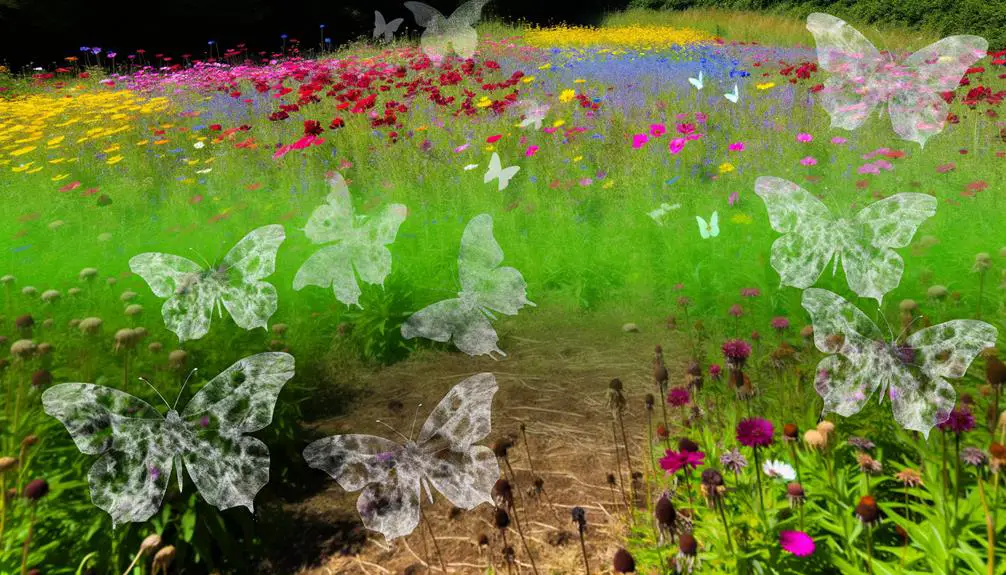
The extinction of butterflies would markedly disrupt plant pollination processes, as these insects play an essential role in the reproductive cycles of numerous flowering plants.
Butterflies, through their foraging activities, facilitate the transfer of pollen grains from one flower to another, ensuring genetic diversity and the production of seeds. Their unique feeding habits, which involve accessing nectar deep within flowers, make them particularly effective pollinators for certain plant species that other pollinators might overlook.
Without butterflies, many plants would face reduced pollination efficiency, potentially leading to lower reproductive success and declining plant populations.
This could trigger cascading ecological effects, altering plant community compositions and impacting other organisms dependent on these plants for habitat and sustenance.
Effects on Food Crops
Given the critical role butterflies play in the pollination of various food crops, their extinction would result in significant disruptions to agricultural productivity and food security.
Butterflies are key pollinators for crops such as tomatoes, peppers, and certain types of beans. Without their pollination services, these crops would experience reduced yields, directly affecting both farmers' livelihoods and food availability.
The decline in these essential crops would necessitate increased reliance on alternative pollinators or artificial pollination methods, both of which could be cost-prohibitive and less efficient.
Additionally, the resultant decrease in crop diversity could exacerbate monoculture dependencies, making agriculture more vulnerable to pests and diseases, thereby magnifying the risk to global food security.
Disruption of Food Chains
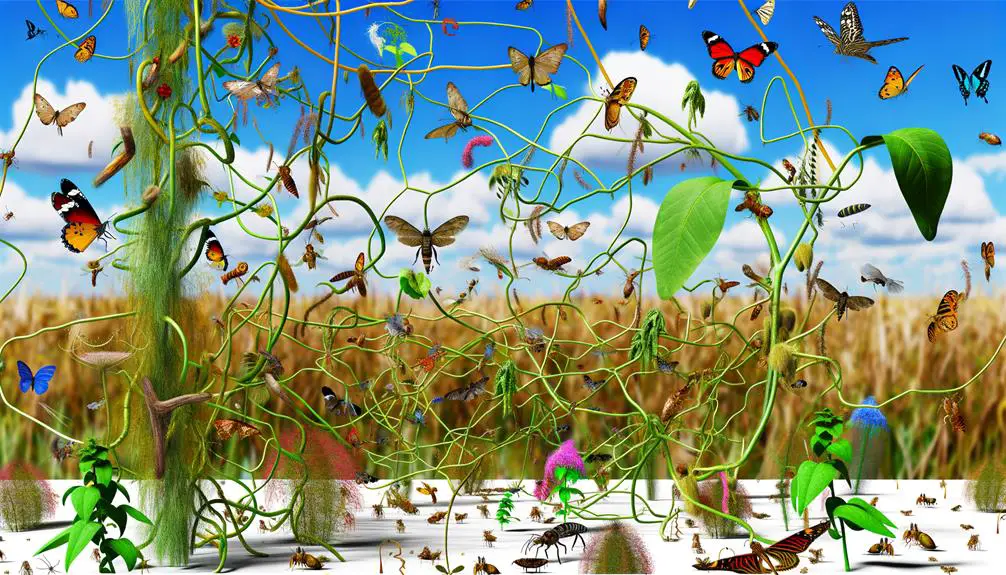
The extinction of butterflies would lead to a significant disruption in food chains, primarily through the alteration of predator-prey balances and the breakdown of pollination networks.
Predators that rely on butterflies as a food source would face declines, potentially causing cascading effects throughout the ecosystem.
Additionally, the reduction in pollination services provided by butterflies could severely impact the reproductive success of various plant species, further destabilizing ecological communities.
Predator-Prey Balance Shift
As butterflies play an essential role in the food web, their extinction would lead to a significant disruption in predator-prey dynamics, affecting numerous species that rely on them for sustenance.
Predators such as birds, spiders, and small mammals would face a sudden scarcity of food, potentially leading to population declines or shifts in dietary habits.
The absence of butterflies could force these predators to overexploit alternative prey, thereby destabilizing other insect populations and causing a cascading effect throughout the ecosystem.
Additionally, such imbalances could lead to increased competition among predators, further straining ecological niches.
This disruption highlights the intricate interdependencies within ecosystems and underscores the far-reaching consequences of losing a seemingly small but crucial component like butterflies.
Pollination Network Breakdown
Beyond disrupting predator-prey relationships, the extinction of butterflies would greatly impair pollination networks, thereby threatening the stability of food chains and ecosystem health.
Butterflies play an essential role in pollinating a variety of flowering plants. Their absence would lead to:
- Reduced Plant Reproduction: Many plants rely on butterflies for successful cross-pollination.
- Decline in Plant Diversity: A decrease in pollinated plants would reduce biodiversity.
- Impact on Herbivores: Animals that feed on certain plants would face food shortages.
- Economic Consequences: Agricultural yields of crops dependent on butterfly pollination, such as fruits and vegetables, would diminish, impacting food supply and economy.
Thus, the extinction of butterflies would cause a cascading effect through ecosystems and human industries.
Decline in Bird Populations
The extinction of butterflies would lead to a significant reduction in food sources for many bird species, particularly those that rely on caterpillars and adult butterflies as primary nutrition.
This loss would disrupt ecosystem balance, causing cascading effects throughout the food web.
Consequently, decreased availability of essential food resources could result in lower bird reproduction rates and a subsequent decline in bird populations.
Reduced Food Sources
A significant decline in butterfly populations would lead to a reduction in food sources for various bird species, thereby disrupting avian ecological balance. Butterflies, particularly in their larval stage, are an essential part of the diet for many birds. The absence of this food source would have several cascading effects:
- Nutrient Deficiency: Birds may suffer from inadequate nutrition, impacting their health and reproductive success.
- Predatory Shift: Birds may shift their predation to other insects, potentially destabilizing those populations.
- Population Decline: A decrease in food availability could lead to a decline in bird populations, particularly those species that rely heavily on butterflies.
- Behavioral Changes: Birds may alter their foraging habits, which could have further ecological ramifications.
Through these impacts, the broader ecosystem would face significant disruptions.
Disrupted Ecosystem Balance
As bird populations decline due to the lack of butterflies as a food source, the intricate balance of ecosystems faces severe disturbances.
Birds play vital roles in pest control, seed dispersal, and pollination. Without butterflies, many bird species would struggle to find adequate nutrition, leading to reduced survival rates and population sizes.
This decline disrupts the food web, affecting other predators and prey. In addition, the absence of birds could result in unchecked insect populations, causing agricultural damage and altering plant community structures.
The cascading effects on biodiversity and ecosystem services underscore the essential interdependence within natural systems, highlighting the profound consequences butterfly extinction would have on ecological stability and health.
Decreased Bird Reproduction
Declines in butterfly populations precipitate a significant reduction in bird reproduction rates, primarily due to the scarcity of essential nutrients that butterflies provide. Butterflies are a fundamental food source for many avian species, particularly during the breeding season. Their absence can lead to:
- Nutritional Deficiency: Butterflies and their larvae are rich in proteins and fats necessary for chick development.
- Reduced Brood Sizes: Birds may lay fewer eggs or abandon nests due to inadequate food.
- Higher Mortality Rates: Increased competition for alternative food sources can result in higher juvenile mortality.
- Behavioral Changes: Birds may exhibit altered foraging behaviors, expending more energy to find sufficient food.
This trophic cascade underscores the interconnectedness of ecosystems and the essential role butterflies play in sustaining avian populations.
Loss of Biodiversity
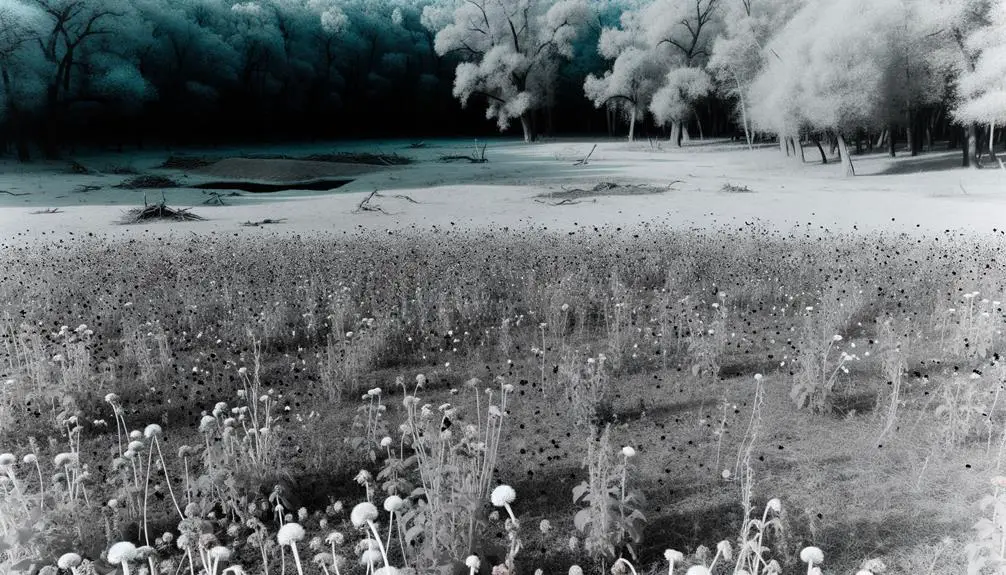
The extinction of butterflies would greatly disrupt ecosystems, leading to a cascading loss of biodiversity.
Butterflies are pivotal pollinators for numerous plant species; their absence would reduce plant reproduction and genetic diversity. This decline would affect herbivores reliant on these plants, further impacting higher trophic levels, including predators.
Additionally, butterflies serve as bio-indicators, signaling the health of an ecosystem. Their extinction could mask underlying environmental issues, delaying necessary interventions.
The intricate web of life—from plants to insects to birds and mammals—would unravel, diminishing ecosystem resilience and functionality.
The loss of butterflies could hence initiate a domino effect, eroding the biodiversity that is essential for ecological balance and the sustainability of life on Earth.
Economic Consequences
The extinction of butterflies would lead to significant economic consequences, primarily through the loss of their pollination services, which are essential for numerous crops.
This reduction in pollination efficiency could result in decreased agricultural yields, directly impacting food supply and increasing the cost of agricultural production.
Consequently, farmers might face higher operational costs and consumers could see a rise in food prices, affecting global food security and market stability.
Pollination Service Loss
Should butterflies go extinct, the loss of their pollination services could inflict significant economic consequences on agricultural industries dependent on pollinator activity.
Butterflies contribute to the pollination of numerous crops and wild plants, thereby supporting biodiversity and agricultural productivity.
The economic impact can be illustrated through several key areas:
- Crop Yield Reduction: Decreased pollination efficiency can lead to lower yields of fruits, vegetables, and nuts.
- Increased Pollination Costs: Farmers may need to rely more on human or mechanical pollination, raising operational costs.
- Market Prices: Reduced supply of pollinated crops can drive up food prices, affecting market stability.
- Ecosystem Services: The broader ecological functions provided by butterflies, such as supporting other wildlife, would diminish, indirectly impacting various economic sectors.
These factors underline the critical role butterflies play in sustaining agricultural economies.
Agricultural Yield Impact
How might the extinction of butterflies precipitate a decline in agricultural yields, leading to profound economic consequences?
Butterflies are pivotal pollinators for a wide variety of crops, including fruits, vegetables, and nuts. Their extinction would disrupt these pollination services, resulting in decreased crop yields.
Reduced agricultural productivity could lead to higher prices for essential food items, exacerbating food insecurity. Farmers would face increased production costs, potentially leading to economic instability in agricultural communities.
Additionally, the ripple effects would extend to industries reliant on agricultural outputs, such as food processing and retail.
The cumulative economic impact underscores the importance of preserving butterfly populations to maintain ecological balance and safeguard agricultural sustainability.
Changes in Ecosystem Dynamics
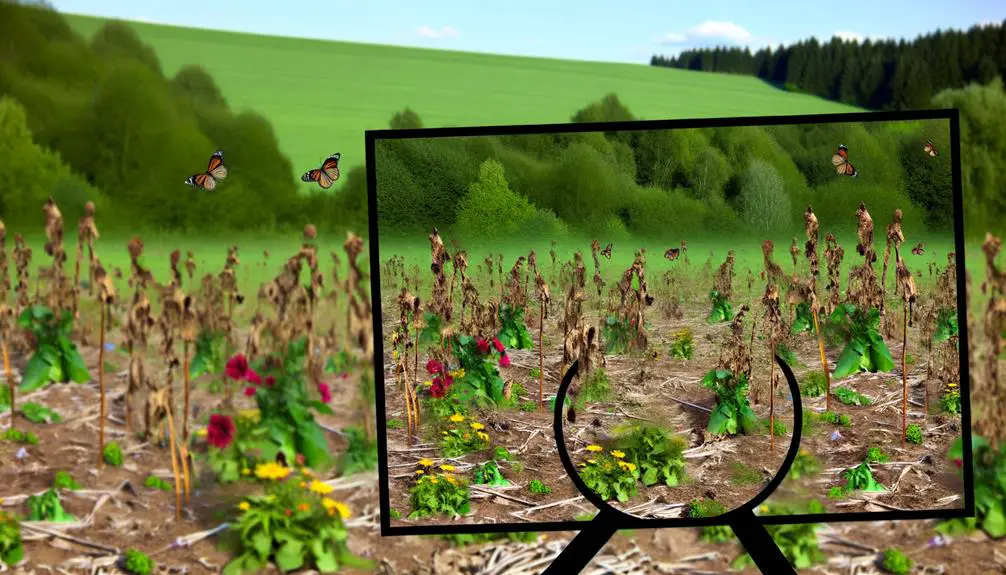
Disruptions in ecosystem dynamics would be profound if butterflies were to go extinct, affecting pollination networks and the food web. Butterflies play a vital role in maintaining ecological balance. Their absence would lead to:
Reduced Pollination: Many plants depend on butterflies for pollination, and their extinction would decrease plant reproduction rates, ultimately affecting plant diversity.
Food Web Alterations: Butterflies serve as prey for numerous species, including birds and small mammals. Their loss would disrupt these predators' food sources, causing a ripple effect through the food web.
Plant-Herbivore Interactions: Caterpillars, the larval stage of butterflies, are significant herbivores. Their absence would alter plant growth dynamics.
Secondary Pollinators Overburdened: Bees and other pollinators would face increased pressure, potentially leading to their decline and further ecosystem imbalance.
Impact on Human Nutrition
The extinction of butterflies would greatly impact human nutrition by diminishing the availability and diversity of crops that rely on butterfly pollination.
Butterflies are essential pollinators for various fruit and vegetable crops, including cucumbers, tomatoes, and certain berries.
A decline in these pollinators would lead to reduced crop yields, compromising the nutritional quality and variety of the human diet.
This reduction could exacerbate food insecurity and increase dependency on less nutritious, mass-produced crops.
In addition, the loss of butterfly pollination services would necessitate increased reliance on artificial pollination methods, elevating production costs and potentially making healthy foods less accessible.
Consequently, butterflies play an indispensable role in maintaining the nutritional balance and sustainability of human food systems.
Role of Butterflies in Culture
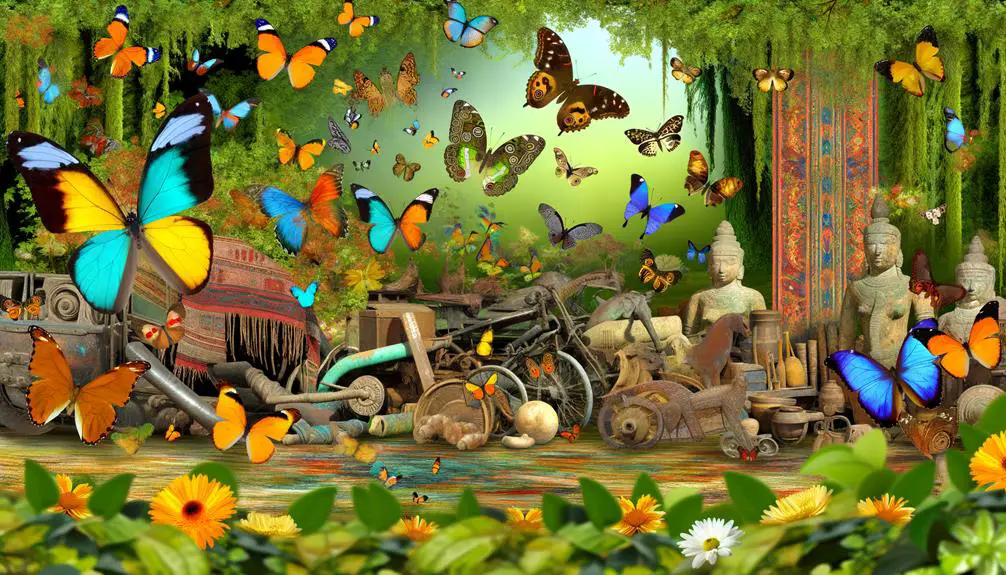
Beyond their ecological and nutritional significance, butterflies hold a profound place in various cultures around the world, symbolizing transformation, beauty, and the intricate interconnectedness of life. Their cultural roles are diverse: In many traditions, they are seen as messengers of the spirit world, representing the cycle of life, death, and rebirth. The delicate and intricate butterfly egg appearance itself reflects themes of renewal and potential, as it marks the humble beginning of a creature that will undergo a remarkable metamorphosis. Across literature and art, butterflies frequently serve as symbols of hope, resilience, and the fleeting nature of existence.
- Symbolism: Butterflies often represent rebirth and transformation, evident in mythologies and literature.
- Art and Aesthetics: Their vibrant colors and delicate structures inspire numerous artistic expressions, from paintings to fashion.
- Rituals and Traditions: Some cultures incorporate butterflies in ceremonies and festivals, viewing them as messengers or omens.
- Educational Value: Butterflies serve as a gateway for educating the public about biodiversity and the importance of conservation.
The extinction of butterflies would not only disrupt ecological balance but also erode these rich cultural narratives and educational opportunities.
Conservation Efforts and Challenges
Conservation efforts to protect butterfly populations are hampered by habitat loss, climate change, and pesticide use, posing significant challenges to their survival.
The destruction of natural habitats due to urbanization and agricultural expansion reduces available resources for butterflies. Climate change exacerbates these issues by altering temperature and precipitation patterns, impacting butterfly migration and breeding cycles. Additionally, widespread pesticide use contaminates their food sources, leading to population declines.
Conservation strategies must include habitat restoration, climate resilience measures, and the promotion of pesticide alternatives. Thorough monitoring and research are essential to adapt conservation actions to emerging threats.
Collaboration among governments, NGOs, and communities is critical to implementing effective conservation practices and ensuring the long-term survival of butterfly species.
Conclusion
The extinction of butterflies would resemble the removal of a keystone from an ancient arch; the intricate balance of pollination, food chains, and biodiversity would crumble, causing widespread ecological disruption.
Plants would falter without their delicate messengers, food crops would yield less, and birds would find fewer nectars and insects to sustain them.
The loss would ripple through ecosystems, eroding human nutrition and cultural heritage.
Conservation efforts are essential to prevent such a collapse and maintain ecological harmony.

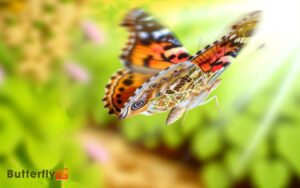





It can come as a surprise that Anavar, for girls, regardless of being a steroid hormone, can cause fewer unwanted facet effects than HGH.
While HGH has a different side effect profile, most people will nonetheless experience
some of them, even at lower doses. There are more than 7000 natural peptides that we presently know about[3].
Peptides, at their most elementary, are just strings of amino
acids (the constructing blocks of protein). Trenbolone at 400mg weekly and Testosterone at 100mg weekly
are helpful within the final half of the cycle, with Anavar and T3 solely
included in the last third of the cycle; for a 24-week
cycle, these two compounds would be used only for the
ultimate eight weeks.
This makes HG more appealing since there’s reduced threat of unfold of infections through contaminated needles.
HGH supplements are also fairly cheaper and extra reasonably priced than steroids.
Unlike steroids, HGH isn’t addictive subsequently there’s no threat of withdrawal issues and
cravings. In Addition To building muscle, HGH is
thought to be helpful in slowing down the getting
older course of, will increase stamina and
total power. Your muscle positive aspects using HGH will heavily depend
on which (if any) anabolic steroids you stack it with,
as this is the commonest strategy. HGH will compound upon the anabolic
and muscle-building results of steroids. Utilizing a strong bulking
steroid with HGH may see you gaining 10-20lbs of muscle in a regular cycle.
In kids, it causes early puberty, advances in bone age, modification of sexual characteristics and cancer development (Bergman et al.,
2013). It also causes feminization results in males,
infertility, lowered fertility, inhibition of
the event of sexual organs and intercourse reversal
in females (Hoga et al., 2018). To prevent customers from affected
by attainable health risks, the utilization of steroid hormones in fish culture has been banned or restricted
in lots of nations and organizations (Li et al., 2018). The Joint FAO/WHO Professional Committee
on Food Components (JECFA) established a suitable day by day consumption of testosterone, progesterone, and estrogen on the fee of 2 μg/kg, 30 μg/kg, and 0.05 μg/kg body weight,
respectively (JECFA, 2000). This single-center examine analyzed OHD patients across diverse ages and pubertal phases, inspecting steroid hormone profiles, glucocorticoid dosage, and growth parameters.
There are combinations of therapies that have been tested along with
the administration of HGH. One of them is its administration with endurance training in older women, which achieves a marked increase in muscle citrate
synthase activity and a rise in muscle L-3-hydroxyacil-CoA dehydrogenase activity.
Many strategies are used for the evaluation of steroid hormones
in fish, but on this examine, the HPLC-UV detection methodology was used for evaluation. The major objective of this research was to
analyze whether or not fish have steroid hormones of their flesh at a dangerous concentration on the time of marketing and also know the farmers’ data, attitudes and practices relating to hormone use.
While both peptides and steroids have their place in drugs and efficiency enhancement, they differ considerably in their construction, mechanism
of motion, unwanted side effects, and purposes. Peptides, similar to development
hormone-releasing peptides, are extra focused, work with
the body’s pure processes, and tend to have minimal side effects.
Steroids, on the opposite hand, usually have a extra widespread and potent impact, however they come with the next risk of
opposed reactions and long-term health penalties.
In the world of efficiency enhancement, anti-aging, and
therapeutic medication, both peptides and steroids have gained appreciable attention for their ability to influence
biological features.
He stabilized over the following 24 hours and was recognized with new onset diabetes.
Injecting it without taking in carbohydrate can result in a disastrous
drop in blood glucose. That, in turn, may cause an individual to move out all of a sudden or, relying on the
dose used, lapse right into a coma. The coma
impact has actually happened to a quantity of well-known skilled bodybuilders.
Nevertheless, it’s necessary to notice that no studies so far have investigated the effects
of GHSs in bodybuilders or other well-trained individuals.
In addition to HGH on the market on our site,
we offer Injectable Steroids and Oral Steroids. It is commonplace to
actually do blood exams and see where your blood markers are.
Blood ldl cholesterol, pressure, irritation, blood sugar, estrogen, thyroid
perform, and so on. Hanging a steadiness between optimizing gains and minimizing potential harm, the exploration of safer steroid
practices requires continuous awareness and informed
decision-making.
This consists of providing the correct temperature, air high quality, air flow, lighting and feeder and drinker house to obtain optimum efficiency.
The right setting, coupled with high-quality feed and superior genetics, yields a fowl that doesn’t
require and wouldn’t profit from growth hormones.
After minipuberty occurs, throughout childhood the hypothalamus-pituitary-gonadal
system turns into quiescent.
Sadly, this is one drug that is almost inconceivable to get a doctor’s prescription.
Girls may expertise deepening of the voice, facial hair progress,
infertility, and irregular menstrual cycles. It is opposite to catabolic
reactions, which discuss with breaking down any tissue of the body.
HGH requires persistence to see results as a outcome of it takes
many months to see its full benefits. HGH cycles are beneficial to be at least three months
in length and infrequently as much as six months for optimum benefit.
Anyone who has used real pharmaceutical-grade HGH will often say it was properly value their funding.
The excessive value is justified by the high-quality HGH
that delivers the expected results at the correct dosage.
After all, HGH is something you’ll be using for lots of months, so if you’ve bought a questionable generic version and are dissatisfied in your outcomes, you’ve not
only wasted a lot of money however probably several months of a cycle.
These are normally very short-term and sometimes subside inside a brief time of starting
HGH use. Many HGH customers will experience pain in the
joints, muscle tissue, and/or nerves. Some will develop carpal tunnel syndrome, the place a nerve that goes into
the hand is compressed due to swelling.
If you might have a growth hormone deficiency,
supplementation of human growth hormone injections can improve your quality of life.
This hormone is used by some athletes together with either anabolic
steroids to extend their muscle mass or EPO to increase their cardio energy.
Detection of rhGH continues to be controversial, but it seems that the direct technique primarily
based on the ratio of a number of circulating forms is the most
promising one. As the outcomes of controlled studies are typically not in agreement with subjective underground reviews
by misusers, it’s tough to draw any particular conclusions regarding the consequences of excessive hGH administration on skeletal muscle perform.
It must be confused that the routine of hGH use in sport is designed to fulfil
functions other than just a rise in athletes’ muscle mass.
The doses concerned are certainly specific to a discipline, its training model, and tailored to the regimen of different ergogenic substances getting
used concurrently. The steady publicity of these hormones to
contaminated fish causes many health disorders in children and adults (Hoga et al., 2018).
HGH will stimulate the manufacturing of IGF-1 – an anabolic hormone that’s highly beneficial to us as bodybuilders.
Your physique secretes sufficient growth hormone from the pituitary gland to supply for
the body’s essential features. Taking exogenous HGH amplifies these mechanisms of motion considerably.
The catabolic actions of cortisol resulting in muscle proteolysis occur largely through the ubiquitin–proteasome
and lysosomal systems (186, 209–211). By Way Of these proteolytic methods, expression of genes concerned
in atrophy (“atrogenes”) are elevated, which goal proteins for degradation by the proteasome machinery (210).
Glucocorticoids additionally may blunt skeletal muscle protein synthesis by inhibiting IGF-I signaling,
a muscle anabolic growth factor, and growing myostatin signaling, a muscle catabolic growth issue, contributing to muscle atrophy (207,
209, 210).
References:
JBHNews
To scale back the chances of gynecomastia occurring on testosterone, our patients regularly take a SERM
such as Nolvadex. Gynecomastia is a priority when biking testosterone
because of its high aromatization, that means a significant quantity of exogenous testosterone will convert
into estrogen. Though not deleterious in nature, manboobs can have a
adverse psychological influence as nicely as being physically undesirable for some users.
Winstrol may even elevate liver enzymes notably, so shorter
cycles are generally applied (not past 6–8 weeks).
Prednisone has a drug half-life of only around three hours, that
means that half the drug is eradicated from the physique in three hours.
Nonetheless, it could trigger side effects, particularly at
high doses or with lengthy use. To reduce the chance, your healthcare supplier will prescribe prednisone at the lowest
dose and for the shortest time frame. Consuming a balanced food plan and sustaining a wholesome weight
may help you lose stomach fat. Avoiding sugary meals, similar to fructose-sweetened drinks, can also present
some benefit. Speak with your healthcare supplier about
food regimen and train changes to manage cortisol ranges.
If you’ve been prescribed steroids, it’s necessary to know that they will have
a huge impact in your urge for food, causing a major enhance
in how much you need to eat.
Outcomes of the examine point out that blood eosinophils significantly decreased with prednisone treatment
(compared to the placebo), whereas leptin levels remained unchanged.
Moreover, there have been no differences in caloric intake, physique fat, or
physique composition – among prednisone recipients compared to the placebo customers.
Though not all prednisone customers will expertise clinically important weight achieve during treatment, many users will report weight acquire as a facet effect.
Data from a majority of randomized managed trials point out that weight gain is doubtless considered one of the most common unwanted effects of prednisone remedy.
An unusually large or bloated stomach in bodybuilders isn’t typically a sign of anabolic steroid consumption. It’s typically brought on by the overuse of insulin or the HGH (human growth hormone) and is often known as
the “HGH gut.” However, bodybuilders who use these chemical compounds are likely to make use
of different steroids. Muscle production is usually
credited to testosterone or the “t-hormone” produced
naturally by the human physique.
That’s likely as a outcome of, within the 90s, HGH was not but frequent in bodybuilding stacks.
Some bodybuilders usually devour monumental amounts of food after taking insulin so
as to keep away from hypoglycemia. The stretching effect of food on the stomach, together
with the growth-stimulating effect of HGH, may probably contribute to the development of
palumboism. In truth, the animals had a % increased mass of
their intestinal mucosa compared to regular rats. While these findings may not totally translate into humans, it supplies a believable mechanism by way of which HGH could contribute to bubble gut.
Contemplating the reality that bubble gut is generally unique to competitive
bodybuilders, the more than likely reason for the situation is the abuse of 1 or a number of PEDs.
Studies also report that top ranges of HGH within the body,
corresponding to in patients with acromegaly, can lead
to the slower transit time of food in the
digestive system.
Trough levels characterize the therapeutic target instantly previous to the
next dose and are lower than regular state targets (e.g. 13.9–24.3 nmol/L) beneficial for topical treatment [10].
The treatment is called testosterone substitute therapy and is carried out under medical supervision. It can be administered as
a supplement, pores and skin patch, cream or injection.
Legally prescribed HGH remedy and managed by a medical doctor
can’t trigger a bubble gut. In the video, he appears with a bulging midsection and bloated abdomen despite also having visible abs.
However, the video is the only occasion the place Joe Rogan has appeared
with a bubble gut, so it’s unknown if that is the everlasting condition of his stomach or just a diet-related momentary state.
It’s important to note that the bubble intestine has usually occurred
in the path of the top of the competitive careers of these
bodybuilders. This suggests a cumulative effect of long-term HGH abuse and a possible function of growing older within the occurrence of
HGH gut. That’s why scientists can’t but answer the question about how the combination of steroids for women’s Weight Loss, HGH, and other anabolic substances could cause the
prevalence of bubble intestine. However to realize these advantages, bodybuilders usually
take excessive doses of HGH and different PEDs, which may lead to
side effects such as HGH intestine.
Nonetheless, a few situations of feminine Palumboism have surfaced over time, proving
that whereas it’s unusual, it’s not unimaginable. These uncommon instances typically raise the identical questions on drug use, organ progress, and extreme dietary practices which
are debated within the male bodybuilding world. Focusing heavily on heavy
lifts while neglecting correct core training can weaken the deep stomach muscular tissues.
In addition, relying too much on weightlifting belts might reduce the engagement of core stabilizers.
Photos of Palumbo’s bloated midsection rapidly spread across bodybuilding forums
and social media, drawing widespread attention, criticism,
and hypothesis.
Earlier work by Bello et al. (2015) documented weight achieve in 65%
of patients receiving prednisone for the treatment of
Duchenne muscular dystrophy. Despite the reality that most patients (65%) didn’t choose one drug over the opposite, patients with a preference most well-liked methylprednisolone
– possibly as a outcome of lower common weight gain. Da Silva, Jacobs, Kirwan, et al.
published a paper discussing the security of
low-dose glucocorticoids within the therapy of rheumatoid arthritis.
In the paper, it was noted that some of the widespread results of excessive glucocorticoid concentrations is
redistribution of body fats. Wung, Anderson, Fontaine, et al.
evaluated data from a trial during which 157 patients acquired glucocorticoids (e.g.
prednisone) for the therapy of the inflammatory disease Wegener’s Granulomatosis.
This is a uncommon disease that occurs when the adrenal
glands do not produce enough of the corticosteroid that the physique needs.
To reduce inflammation of the nerves, corticosteroids are
a typical therapy for MS. While the condition cannot be cured, this form of treatment
may help decrease symptoms5. This can enhance your urge for food, resulting in weight gain, and specifically result in additional deposits of fat in your stomach.
As your fitness improves and your hourly energy
and hydration necessities increase, your physique adapts so you
can course of more food and fluids extra
rapidly. Individual sugars (glucose, fructose, galactose) want
transporters to get by way of the intestinal wall,
and increased carbohydrate consumption during training will increase the transporters you’ve available.
This is part of the explanation some athletes can tolerate ninety grams of carbohydrate per
hour while absorption is limited to about 60 grams per
hour for most people.
Whereas both teams misplaced muscle mass as properly as fat mass on a low-calorie food regimen, testosterone brought on significant muscle regain in the course
of the weight upkeep interval (24). While valid testosterone substitute remedy could promote weight reduction in overweight males,
anabolic steroid misuse isn’t a beneficial weight loss strategy.
One of its most necessary functions in each genders is to hold up muscle
mass and promote muscle development and bone energy. Your levels decline with age, partly explaining age-related muscle and bone
loss. The draw back to this cycle is that it is particularly cardiotoxic, with blood pressure rising significantly.
Customers can incorporate common cardiovascular train into their schedule to reduce cardiac
strain.